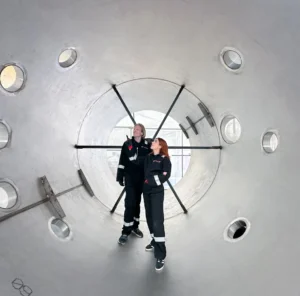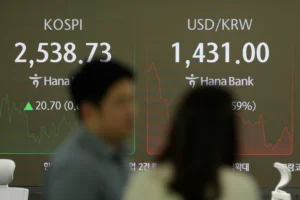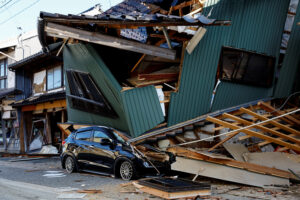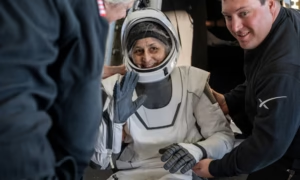Iceland Volcano Eruption Forces Evacuations: A Town in Peril and a Fiery Display of Nature’s Power
A volcanic eruption in southwest Iceland has forced the evacuation of tourists and residents, with authorities warning of a serious threat to the fishing town of Grindavik and the Blue Lagoon, one of the country’s most famous geothermal attractions.
The eruption, which began early in the morning, has produced a dramatic fiery display of lava, creating a massive 1.2 km (0.75 miles) long fissure in the earth’s surface. The event has also been accompanied by multiple earthquakes, further unsettling the region.
Despite evacuation orders, a small number of residents have refused to leave their homes, according to local media. Some residents, accustomed to living near an active volcanic zone, have had their bags packed for emergencies, yet this time, the situation feels different due to the constant seismic activity.
With lava flows breaching protective barriers around the town, and a newly opened eruptive fissure inside the safety zone, officials are deeply concerned about Grindavik’s future.
The Scale of the Eruption
- The eruption, which started at 9:45 AM local time (10:45 BST), has led to the formation of a 1.2 km-long fissure in the ground.
- Magma activity beneath the crater series stretches 11 km (6.8 miles), making it the longest magma corridor recorded since November 11, 2023.
- The Icelandic Meteorological Office (IMO) has confirmed that the magma extends 3 km (1.86 miles) further northeast than in previous eruptions, increasing concerns about lava reaching inhabited areas.
- The town of Grindavik, home to 4,000 residents, has been evacuated several times since 2023 due to repeated volcanic activity in the area.

Fears of Lava Reaching Grindavik
With protective barriers failing and lava encroaching on the town, concerns are growing. According to Rikke Pedersen from the Nordic Volcanological Centre, there is a real risk that lava flows could enter Grindavik’s inhabited areas.
The police commissioner of the region, Ulfar Ludviksson, urged all individuals to leave the danger zone, but acknowledged that some residents in “seven or eight houses” have refused to evacuate.
One such resident, Asrun Kristinsdottir, who serves as president of Grindavik’s town council, described the scene as “extremely difficult to witness.” She had lived near the volcano for most of her life and always had emergency bags packed, but this eruption felt more ominous due to the relentless earthquakes shaking the region.
The Impact on Infrastructure
The eruption is already causing damage to critical infrastructure, including:
- A broken hot water pipe in the northern part of Grindavik, suggesting severe ground cracking has occurred.
- Possible disruption to roads and transport networks, making evacuation more difficult.
- Concerns about gas pollution, which, based on current wind directions, could drift northeast toward the capital area, Reykjavik.
A Community in Crisis
For Thormar Omarrson, who ran a pizza restaurant in Grindavik, the eruption has been heartbreaking.
Omarrson and his family relocated in 2024 after government warnings about the increasing risk of volcanic eruptions. Still, watching their hometown succumb to natural forces has been devastating.
“My family was born and raised in Grindavik, and now their community is gone,” Omarrson told the BBC.
Yet, despite the evacuation orders, some of his friends refuse to leave.
“When you live there in your home, you want to be left alone in your home,” he said, describing the deep connection many locals have with their land despite the looming danger.
Tourists Evacuated from the Blue Lagoon
The Blue Lagoon, Iceland’s world-famous geothermal spa, has also been evacuated as a precautionary measure.
The spa, which attracts hundreds of thousands of visitors every year, sits near the volcanically active Reykjanes Peninsula and has had to close multiple times since the eruptions in 2021.
Iceland’s Volcanic History and the Mid-Atlantic Ridge
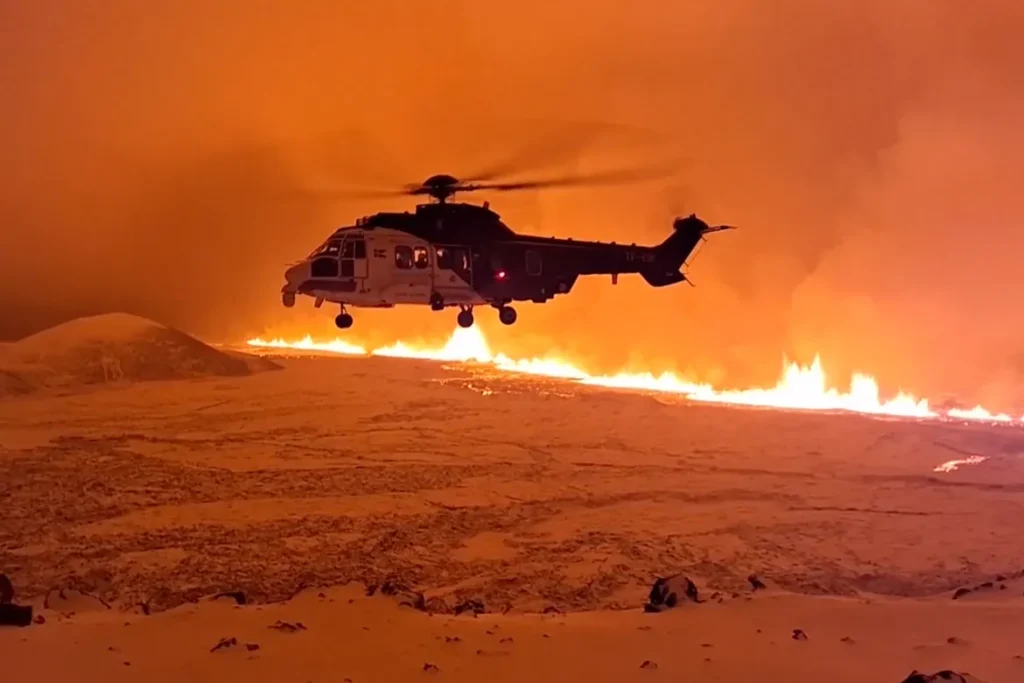
Why is Iceland So Volcanically Active?
Iceland is home to 33 active volcanic systems, making it one of the most geologically active regions on Earth.
The country sits on the Mid-Atlantic Ridge, the boundary between the North American and Eurasian tectonic plates. As these two plates pull apart, magma rises from beneath the Earth’s crust, fueling frequent volcanic eruptions.
The Reykjanes Peninsula – A Hotspot for Eruptions
The Reykjanes Peninsula, where this latest eruption occurred, had no volcanic activity for 800 years—until 2021.
Since then, the region has experienced multiple eruptions, marking the start of what scientists believe could be a new volcanic era lasting decades.
Historical Volcanic Eruptions in Iceland
1. Eyjafjallajökull (2010) – The Volcano That Shut Down Air Travel
One of the most infamous volcanic eruptions in recent memory was the Eyjafjallajökull eruption in 2010.
- The ash cloud grounded flights across Europe for weeks.
- Over 100,000 flights were canceled, affecting millions of passengers worldwide.
- It caused economic losses of nearly $5 billion in the aviation industry.
2. Laki Eruption (1783-1784) – The Deadliest Eruption in Iceland’s History
The Laki eruption lasted eight months, releasing vast amounts of sulfur dioxide into the atmosphere.
- 25% of Iceland’s population perished due to famine and poisoning.
- The climate across Europe was affected, leading to failed crops and extreme weather changes.
3. The Ongoing Reykjanes Peninsula Eruptions (2021-Present)
Since 2021, the Reykjanes Peninsula has experienced several eruptions, indicating that Iceland is entering a new cycle of volcanic activity.
The current Grindavik eruption is part of this ongoing geological phenomenon.
Iceland has some of the world’s most advanced volcanic monitoring systems, including:
- Real-Time Seismic Monitoring – The Icelandic Meteorological Office (IMO) tracks earthquake activity and magma movement in real-time.
- Lava Barriers – The government is building defensive barriers around towns like Grindavik.
- Evacuation Plans – Local communities practice regular evacuation drills in case of emergencies.
- Gas and Ash Warnings – The IMO provides early alerts about toxic gas emissions and ash clouds that could affect air quality.
With continuous eruptions since 2021, experts warn that the Reykjanes Peninsula could experience decades of volcanic activity.
For residents of Grindavik, the future remains uncertain. Will the town be permanently abandoned? Or will people return, rebuilding their homes despite the dangers?
One thing is certain—Iceland’s volatile nature will continue to shape the landscape, communities, and the lives of those who call it home.
The Iceland volcanic eruption of 2024 is another reminder of the island’s powerful natural forces.
As lava flows threaten towns, earthquakes shake the land, and evacuations continue, Icelanders remain resilient. For centuries, they have lived with the raw power of nature—adapting, surviving, and rebuilding.
The world watches as Grindavik faces an uncertain future, but one thing is certain—Iceland’s volcanic legacy is far from over.


